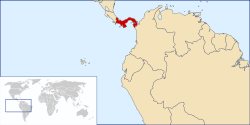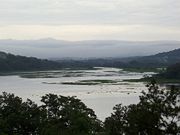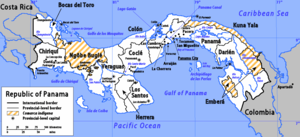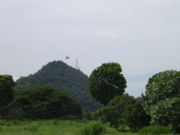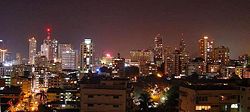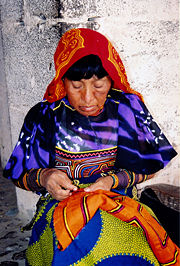Panama
2008/9 Schools Wikipedia Selection. Related subjects: Americas; Countries
| República de Panamá (Spanish) Republic of Panama
|
||||||
|---|---|---|---|---|---|---|
|
||||||
| Motto: "Pro Mundi Beneficio" (Latin) "For the Benefit of the World" |
||||||
| Anthem: Himno Istmeño (Spanish) |
||||||
|
|
||||||
| Capital (and largest city) |
Panama City |
|||||
| Official languages | Spanish | |||||
| Demonym | Panamanian | |||||
| Government | Constitutional Democracy | |||||
| - | President | Martin Torrijos | ||||
| - | First Vice President | Samuel Lewis | ||||
| - | Second Vice President | Rubén Arosemena | ||||
| Independence | ||||||
| - | from Spain | 28 November 1821 | ||||
| - | from Colombia | 3 November 1903 | ||||
| Area | ||||||
| - | Total | 75,517 km² ( 118th) 29,157 sq mi |
||||
| - | Water (%) | 2.9 | ||||
| Population | ||||||
| - | Dec 2006 estimate | 3,320,000 ( 133rd) | ||||
| - | May 2000 census | 2,839,177 | ||||
| - | Density | 43/km² ( 156th) 111/sq mi |
||||
| GDP ( PPP) | 2006 estimate | |||||
| - | Total | $31.411 billion ( 103rd) | ||||
| - | Per capita | $9,000 ( 83rd) | ||||
| Gini (2002) | 48.5 | |||||
| HDI (2007) | ▲ 0.812 (high) ( 62nd) | |||||
| Currency | Balboa, U.S. dollar ( PAB, USD) |
|||||
| Time zone | ( UTC-5) | |||||
| - | Summer ( DST) | ( UTC-5) | ||||
| Internet TLD | .pa | |||||
| Calling code | +507 | |||||
Panama, officially the Republic of Panama (Spanish: República de Panamá; Spanish pronunciation: [reˈpuβlika ðe panaˈma]), is the southernmost country of Central America. Situated on an isthmus, some categorize it as a transcontinental nation connecting the north and south part of America. It borders Costa Rica to the north-west, Colombia to the south-east, the Caribbean Sea to the north and the Pacific Ocean to the south. It is an international business centre and is also a transit country. Although Panama is also the 3rd largest economy in Central America, after Guatemala and Costa Rica, it has the largest expenditure on resource consumption, making the country the largest consumer in Central America.
History
Pre-Columbian period
Pre-Columbian heritage of native populations whose presence stretched back over 11,000 years. The earliest traces of these indigenous peoples include fluted projectile points. This changed into significant populations that are best known through the spectacular burials of the Conte site (dating to c. AD 500-900) and the polychrome pottery of the Coclé style. The monumental monolithic sculptures at the Barriles ( Chiriqui) site were another important clue of the ancient isthmian cultures. Prior to the arrival of Europeans, Panama was widely settled by Chibchan, Chocoan, and Cueva peoples, among whom the largest group were the Cueva. There is no accurate knowledge of size of the indigenous population of the isthmus at the time of the European conquest. Estimates range as high as two million people, but more recent studies place that number closer to 200,000. Archaeological finds as well as testimonials by early European explorers describe diverse native isthmian groups exhibiting cultural variety and suggesting people already conditioned by regular regional routes of commerce.
Independence
On 3 November 1903, Panama broke off from Colombia. The US gunboat Nashville prevented the Colombian military from sailing to Panama. An assault through the dense Panamanian jungle was impossible. The President of the Municipal Council, Demetrio H. Brid, the highest authority at the time, became its de facto president, appointing a Provisional Government on 4 November to run the affairs of the new republic. The United States, as the first country to recognize the new Republic of Panama, sent troops to protect its economic interests. The 1904 Constituent Assembly elected Dr. Manuel Amador Guerrero, a prominent member of the Conservative political party, as the first constitutional President of the Republic of Panama.
In November 1903, Phillipe Bunau-Varilla—a French citizen who was not authorized to sign any treaties on behalf of Panama without the review of the Panamanians—unilaterally signed the Hay-Bunau Varilla Treaty which granted rights to the United States to build and administer indefinitely the Panama Canal, which was opened in 1914. This treaty became a contentious diplomatic issue between the two countries, reaching a boiling point on Martyr's Day ( 9 January 1964). The issues were resolved with the signing of the Torrijos-Carter Treaties in 1977 returning the former Canal Zone territories to Panama.
Military dictators
The original intent of the founding fathers was to bring peace and harmony between the two major political parties (Conservatives and Liberals). The Panamanian government went through periods of political instability and corruption, however, and at various times in its history, the mandate of an elected president terminated prematurely. In 1968, a coup toppled the government of the recently elected President Arnulfo Arias Madrid.
While never holding the position of President himself, General Omar Torrijos eventually became the de facto leader of Panama. As a military dictator, he was the leading power in the governing military junta and later became an autocratic strong man. Torrijos maintained his position of power until his death in an airplane accident in 1981.
After Torrijos's death, several military strong men followed him as Panama's leader. Commander Florencio Flores Aguilar followed Torrijos. Colonel Rubén Darío Paredes followed Aguilar. Eventually, by 1983, power was concentrated in the hands of General Manuel Antonio Noriega.
Manuel Noriega came up through the ranks after serving in the Chiriquí province and in the city of Puerto Armuelles for a time. He was a former head of Panama's secret police and was an ex-informant of the CIA. But Noriega's implication in drug trafficking by the United States resulted in difficult relations by the end of the 1980s.
United States invasion of Panama
On 20 December 1989, twenty-seven thousand U.S. personnel invaded Panama in order to remove Manuel Noriega. A few hours before the invasion, in a ceremony that took place inside a U.S. military base in the former Panama Canal Zone, Guillermo Endara was sworn in as the new President of Panama. The invasion occurred ten years before the Panama Canal administration was to be turned over to Panamanian authorities, according to the timetable set up by the Torrijos-Carter Treaties. During the fighting, between one thousand and four thousand Panamanians, mostly military, were killed.
Noriega surrendered to the American military shortly after, and was taken to Florida to be formally extradited and charged by U.S. federal authorities on drug and racketeering charges. He became eligible for parole on September 9, 2007, but remained in custody while his lawyers fought an extradition request from France. Critics have pointed out that many of Noriega's former allies remain in power in Panama.
Post-Invasion
Under the Torrijos-Carter Treaties, the United States turned over all canal-related lands to Panama on 31 December 1999. Panama also gained control of canal-related buildings and infrastructure as well as full administration of the canal.
The people of Panama have already approved the widening of the canal which, after completion, will allow for post-Panamax vessels to travel through it, increasing the number of ships that currently use the canal.
Politics
Panama's politics takes place in a framework of a presidential representative democratic republic, whereby the President of Panama is both head of state and head of government, and of a multi-party system. Executive power is exercised by the government. Legislative power is vested in both the government and the National Assembly. The judiciary is independent of the executive and the legislature. All National elections are universal and mandatory to all citizens 18 years and older.
Provinces and regions
Geography
Panama is located in Central America, bordering both the Caribbean Sea and the Pacific Ocean, between Colombia and Costa Rica. Its location on the Isthmus of Panama is strategic. By 1999, Panama controlled the Panama Canal that links the North Atlantic Ocean via the Caribbean Sea with the North Pacific Ocean.
The dominant feature of the country's landform is the central spine of mountains and hills that forms the continental divide. The divide does not form part of the great mountain chains of North America, and only near the Colombian border are there highlands related to the Andean system of South America. The spine that forms the divide is the highly eroded arch of an uplift from the sea bottom, in which peaks were formed by volcanic intrusions.
The mountain range of the divide is called the Cordillera de Talamanca near the Costa Rican border. Farther east it becomes the Serranía de Tabasará, and the portion of it closer to the lower saddle of the isthmus, where the canal is located, is often called the Sierra de Veraguas. As a whole, the range between Costa Rica and the canal is generally referred to by Panamanian geographers as the Cordillera Central.
The highest point in the country is the Volcán Barú (formerly known as the Volcán de Chiriquí), which rises to 3475 meters (11401 ft.). A nearly impenetrable jungle forms the Darien Gap between Panama and Colombia. It creates a break in the Pan-American Highway, which otherwise forms a complete road from Alaska to Patagonia.
Economy

According to the CIA World Factbook, Panama has an unemployment rate of 7.2% and according to the United Nations, the poverty rate is of 24.2% as of 2006, comparable to that of wealthier nations such as Argentina. However, the First World infrastructure and high standards of living shows Panama's strong and thriving economic growth.
Panama's economy is mainly service-based, heavily weighted toward banking, commerce, tourism, trading and private industries because of its key geographic location. The handover of the canal and military installations by the United States has given rise to new construction projects. The Martín Torrijos administration has undertaken controversial structural reforms, such as a fiscal reform and a very difficult Social Security Reform. Furthermore, a referendum regarding the building of a third set of locks for the Panama Canal was approved overwhelmingly (though with low voter turnout) on 22 October 2006. The official estimate of the building of the third set of locks is US$5.25 billion.
The Panamanian currency is the balboa, fixed at parity with the United States dollar. In practice, however, the country is dollarized; Panama mints its own coinage but uses US dollars for all its paper currency. Panama was the first of the three countries in Latin America to have dollarized their economies, later followed by Ecuador and El Salvador.
Globalization
The high levels of Panamanian trade are in large part from the Colón Free Trade Zone, the largest free trade zone in the Western Hemisphere. Last year the zone accounted for 92% of Panama's exports and 64% of its imports, according to an analysis of figures from the Colon zone management and estimates of Panama's trade by the United Nations Economic Commission for Latin America and the Caribbean (ECLAC). Panama's economy is also very much supported by the trade and exportation of coffee.
Inflation
According to the Economic Commission for Latin American and the Caribbean ( ECLAC, or CEPAL by its more-commonly used Spanish acronym), Panama's inflation as measured by weight CPI was 2.0 percent in 2006. Panama has traditionally experienced low inflation.
Real estate
Panama City is currently experiencing a real estate boom. Tourists and retirees are arriving in greater quantities and consequently helping the local real estate market.
Apart from the existing demand, future developments will also be helped by such factors as the planned expansion of the Panama Canal.
Bilateral Investment Treaty with the U.S.
The Bilateral Investment Treaty (BIT) between the governments of the United States and Panama was signed on October 27, 1982. The treaty protects U.S. investment and assists Panama in its efforts to develop its economy by creating conditions more favorable for U.S. private investment and thereby strengthening the development of its private sector. The BIT with Panama was the first such treaty signed by the U.S. in the Western Hemisphere.
The importance of Panama to the U.S. stems from the Panama Canal which was built by the U.S. during the period of 1904-1914. Previously, if ships wanted to pass through the Americas, they would have to go all the way around the most southern tip of South America, the Tierra del Fuego, and through the Drake Passage. The Panama Canal connects the Atlantic and Pacific Oceans directly at the narrowest point in Panama. When previously a ship going from New York to San Francisco would have to travel for 20,900 kilometers (13,000 miles), now that travel time would be reduced to 8370 km (5200 mi).
The canal is of economic importance since it provides millions of dollars from toll revenue as well as a right to include and exclude any other nation or company from using it. The United States had complete monopoly over the Panama Canal for 85 years. However, the Torrijos-Carter Treaties signed in 1977 began the process of returning the canal to the Panamanian government in 1999 as long as they agreed to the neutrality of the canal, as well as allowing the U.S. to return at any time.
Proposed Free Trade Agreement with the United States
A Trade Promotion Agreement between the United States and Panama was signed by both governments in 2007, but neither country has yet approved or implemented the Agreement. While the U.S. Congress was initially favorably disposed to the Panama pact, the election of the anti-American Pedro González, and his possible link with to the assassination of US soldier Zak Hernández, to the presidency of the Panamanian legislature on September 1, 2007 has halted progress of the pact in that body.
Demographics
According to the CIA World Factbook, Panama has a population of 3,242,173. The majority of the population, 70%, is mestizo. The rest is 14% Amerindian and mixed West Indian, 10% white and 6% Amerindian. The Amerindian population includes seven indigenous peoples, the Emberá, Wounaan, Guaymí, Buglé, Kuna, Naso and Bribri. More than half the population lives in the Panama City– Colón metropolitan corridor.
The culture, customs, and language of the Panamanians are predominantly Caribbean and Spanish. Spanish is the official and dominant language. About eight percent of the population speak a creole, mostly in Panama City and in the islands off the northeast coast. English is spoken widely on the Caribbean coast and by many in business and professional fields.
The overwhelming majority of Panamanians is Roman Catholic, accounting for almost 75% of the population. Although the Constitution recognizes Catholicism as the religion of the great majority, Panama has no official religion. Minority religions in Panama include Islam (0.3), the Bahá'í Faith (0.1%), Buddhism (at least 0.5%), Greek Orthodox (0.1%), Judaism (0.4%), and Hinduism (0.3%). The Jewish community in Panama, with over 10,000 members, is by far the biggest in the region (including Central America and the Caribbean). Jewish immigration began in the late 19th century, and at present there are synagogues in Panama City, as well as two Jewish schools. Within Latin America, Panama has one of the largest Jewish communities in proportion to its population, surpassed only by Uruguay, Argentina, Brazil, and Mexico. Panama is also the first country in Latin America to have a Jewish president, Eric Arturo Delvalle. Panama's communities of Muslims, East Asians, and South Asians, are also among the largest.
Panama City hosts a Bahá'í House of Worship, one of only eight in the world. Completed in 1972, it is perched on a high hill facing the canal, and is constructed of local mud laid in a pattern reminiscent of Native American fabric designs.
Panama, because of its historical reliance on commerce, is above all a melting pot. This is shown, for instance, by its considerable population of Chinese origin. Many Chinese immigrated to Panama from southern China to help build the Panama Railroad in the 19th century; their descendants number around 50,000. Starting in the 1970s, a further 80,000 have immigrated from other parts of mainland China as well.
The country is also the smallest in Spanish-speaking Latin America in terms of population (est. 3,232,000), with Uruguay as the second smallest (est. 3,463,000). However, since Panama has a higher birth rate, it is likely that in the coming years its population will surpass Uruguay's.
International rankings
| Index (Year) | Author / Editor / Source | Year of publication |
Countries sampled |
World Ranking (1) |
Ranking L.A.(2) |
| Environmental Performance (2008) | Yale University |
|
149 | 32º |
|
| Democracy (2006) | The Economist |
|
167 | 44º |
|
| Global Peace (2008) | The Economist |
|
140 | 48º |
|
| Economic Freedom (2008) | The Wall Street Journal |
|
157 | 46º |
|
| Quality-of-life (2005) | The Economist |
|
111 | 47º |
|
| Travel and Tourism Competitiveness (2008) | World Economic Forum |
|
130 | 50º |
|
| Press Freedom (2007) | Reporters Without Borders |
|
169 | 54º |
|
| Global Competitiviness (2007) | World Economic Forum |
|
131 | 59º |
|
| Human Development (2005) | United Nations (UNDP) |
|
177 | 62º |
|
| Corruption Perception (2006) | Transparency International |
|
163 | 84º |
|
| Income inequality (1989-2007)(3) | United Nations (UNDP) |
|
126 | 115º |
|
- (1) Worldwide ranking among countries evaluated.
- (2) Ranking among the 20 Latin American countries.
- (3) Because the Gini coefficient used for the ranking corresponds to different years depending of the country, and the underlying household surveys differ in method and in the type of data collected, the distribution data are not strictly comparable across countries. The ranking therefore is only a proxy for reference purposes, and though the source is the same, the sample is smaller than for the HDI
- (2) Ranking among the 20 Latin American countries.


